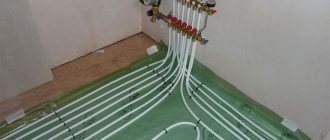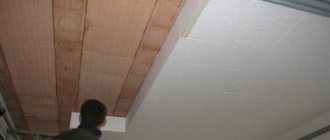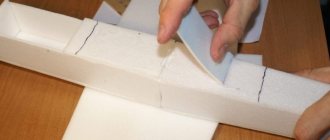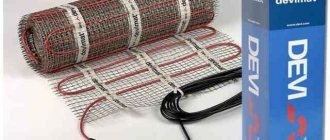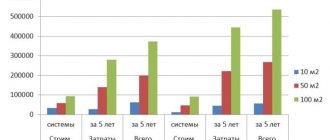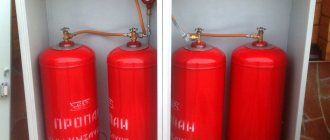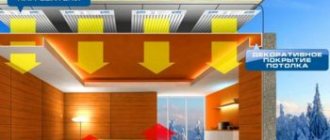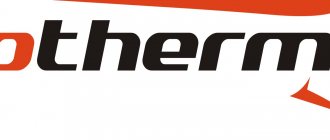Porcelain stoneware is one of the most optimal materials for finishing heated floors. Due to its high density, it has excellent thermal conductivity, which significantly increases heating efficiency. But high density also creates certain difficulties when choosing a specific brand of glue. The fact is that porcelain stoneware has a perfectly flat surface and almost does not absorb water. At the same time, it does not absorb glue; high adhesion should be ensured by adding special innovative fillers.
Adhesive for porcelain tiles on heated floors
General tips for using glue
Warm floors can be of two types, each of them has its own technical features. They have a direct impact on the choice and technology of using adhesive for porcelain tiles on heated floors.
- Electric heated floors. Can be using modern infrared panels or traditional electrical wires. Both options have a small thickness, which makes it possible to lay porcelain tiles without preparing a special cement-sand screed. In this case, the thickness of the glue is in the range of 0.8–1.5 cm. When choosing a composition, carefully study the instructions; manufacturers must indicate the maximum possible thickness of the material without cracking during setting. One more nuance. Polyethylene films of infrared heating are destroyed under the influence of aggressive chemical compounds. If the glue contains such additives, then applying it directly to infrared mats is strictly prohibited; they must be covered with any protective base.
Electric heated floor
- Water heated floors. The large thickness of the coolant tubes requires the creation of a cement-sand screed. In such options for underfloor heating, adhesives for porcelain tiles have a minimum of restrictions; it is allowed to use most commercially available products. This greatly simplifies the process of laying porcelain stoneware slabs.
Water heated floor
The larger the contact area of the tiles with the heating elements, the higher the efficiency of the system. During work, do not leave air pockets between the tiles and the surface of the base; they reduce thermal conductivity. In addition, large porcelain stoneware slabs have uneven temperatures in different areas due to air pockets. This difference has a negative impact on the durability of the flooring.
How to choose glue?
Considering the huge range of products offered for laying ceramic tiles on warm floors, it is not easy to make a final choice. To make this task easier, it is necessary to rely on certain criteria for choosing tile adhesive.
When heated, the components of the adhesive mixture expand, increasing in volume, and when cooled they return to their original state.
Plasticity is an extremely important quality that a composition must have.
Simple mixtures have weak elasticity and, over and over again, experiencing thermal fluctuations, they lose their properties, undergo drying and splitting.
The cracked composition cannot firmly hold the tile and it begins to break off, negating all the work involved in laying it. In addition to damaging the cladding, the voids resulting from the formation of cracks will be filled with air and thermal conductivity will be greatly reduced.
In other words, timely selection of a suitable composition will eliminate unpleasant problems and increase the service life of the ceramic surface.
IMPORTANT: it is better to choose special glue, it has better characteristics than universal glue
Criteria by which you should select an adhesive composition for laying tiles on a heated floor:
- Resistant to regular temperature changes. Depending on individual preferences, the temperature can be lowered or raised as often as necessary for the owners of this heating system. Good, high-quality glue can withstand critical temperatures from -30 to +90 degrees, which means the average room temperature will not be a serious test for it.
- Compatible with finishing material and base.
During application of the adhesive mixture, it adheres tightly to the tile and the main surface. The materials from which the objects are made can be completely different, which means the chemical reaction with the glue will occur differently. This point must be taken into account, since the quality and durability of the cladding fixation depends on it. Usually the packaging of the product indicates which raw materials it is compatible with and can be used. - Resistance to physical pressure. Despite the fact that the cured glue is quite strong, this indicator is also worth paying attention to. A poor quality mixture that is not resistant to heavy loads may allow the facing tiles to move or warp. Glue containing aluminate cement is considered more resistant to mechanical stress.
- Mark on the packaging. The possibility of using a specific mixture for covering a heated floor is indicated by an inscription or symbol. If there is no such mark, then the glue is not suitable for working with an object subject to thermal fluctuations.
- Possibility of choice. On the modern market you can purchase both ready-made, mixed glue and dry cement-adhesive compositions for self-mixing. Most craftsmen are inclined to the second option, since it is cheaper and you can prepare as many raw materials as needed for the job. However, the possibility of purchasing ready-made goods for heated floors is quite relevant in some cases.
- Reputation of the manufacturer. A brand is a guarantee of quality; it is an assessment of a product by professional craftsmen and ordinary users. You should not save too much and buy cheap mixtures from unknown manufacturers, since the quality of such a product is extremely questionable, and the work will be carried out at your own peril and risk. You should make your choice in favor of proven, proven, well-known brands.
Following the general selection recommendations, paying attention to the main indicators, you can select the adhesive composition that is most suitable for the intended finishing work.
List of the most famous brands of adhesive for porcelain tiles for heated floors
The table we offer is not final, but will help inexperienced developers navigate the range of brands and become familiar with the performance indicators of their products.
| Name | Brief characteristics | approximate price |
Ceresit CM 14 | Elastic, waterproof, cement-based adhesive. Plates can be adjusted within 20 minutes, open time 20 minutes. Moisture-resistant, can be used for heated floors, temperature range from -50°C to +70°C, adhesion to porcelain tiles of at least 1 MPa, consumption ≈3 kg/m2. The solution must be used within two hours after preparation. | 420 rub./25 kg |
Stone Flower Granite | For external and internal use, domestic production. After application, the slabs can be adjusted within 10 minutes; can be used for heated floor systems. Consumption 3.5 kg/m2, based on cement. Glue pot life 180 min. Moisture resistant, application thickness 2–4 mm. | 250 rub./25 kg |
Plitonit B+ | For interior work in dry and damp areas, solution pot life 240 min. Produced in Russia, recommended application layer thickness is 1 mm, consumption is no more than 1.3 kg/m2. Can withstand heating up to +70°C, frost resistance of at least 75 cycles. | 440 rub./25 kg |
Knauf Marble | It has increased adhesion rates and can be used in damp areas. Layer thickness is up to 6 mm, specific values are selected taking into account the characteristics of artificial stone tiles and base material. White color, compatible with most types of grout. | 500 rub./25 kg |
Prospectors Plus | Cement-based, pot life four hours, open time 20 minutes. Recommended consumption is 3.3 kg/m2; use in rooms with high humidity parameters is allowed. Not afraid of sudden temperature fluctuations. | 260 rub./25 kg |
Litokol Litostone K98 | Highly elastic, reinforced, quick-hardening. In terms of all operational characteristics, it occupies one of the leading places. Viability no more than 35 minutes, density 1300 kg/m3, cement-based, open time no more than 15 minutes. | 1150 rub./25 kg |
Weber.Vetonit Granit Fix | Can be used on concrete, brick and plasterboard bases, the slabs are adjusted within 15 minutes. after installation. Adhesion of at least 1.1 MPa, manufactured in Russia. Approximate consumption is 1.3 kg/m2, it is allowed to work only at positive temperatures. | RUR 345/25 kg |
Unis Granite | Laying on old tiles without dismantling them is allowed. The thickness of the adhesive layer is up to 10 mm, which allows you to level the bases. Adhesion of at least 1.5 MPa, produced in Russia. Pot life up to 180 minutes, laying time for tiles after applying adhesive is 20 minutes. | 400 rub./25 kg |
Knauf Flex elastic | With increased adhesion and plasticity parameters. Grouting of joints can be done 24 hours after laying artificial stone tiles. Moisture resistant, it is recommended to work only at positive temperatures. On a cement base, the time for adjusting the position of the slabs is up to 10 minutes. | 250 rub./10 kg |
Found Maxiplix AC16 dust-free | Once prepared, you can work for three hours, highly elastic with enhanced hold. Can be used on all types of substrates, adjustment time is no more than 15 minutes. Can be used at temperatures from -50°C to +70°C. | 590 rub./25 kg |
Maxiplix AC16 prof. OSNOVIT dust-free adhesive
As can be seen from the comparative table, all manufacturers promise high performance indicators of their products, but experienced tilers recommend using compositions from world-famous brands. Unfortunately, domestic producers have not yet managed to win the respect of consumers.
Instructions for using glue on heated floors
Initial data: the room has a warm floor with a water heating system, a cement-concrete screed is made on top. There are no defects that require mandatory elimination before laying artificial stone.
To carry out the work, you will need to buy glue for porcelain tiles, a deep penetration primer for concrete surfaces, a notched trowel, a construction ladle and trowel, a container for preparing the solution and an electric mixer. To cut tiles you need a tile cutter, the distance between the seams is set using plastic crosses, the position of the surface is checked with a bubble level. Use a rubber hammer to move the tiles. The primer is applied with a roller or brush.
Step 1: Prepare the surface. Carefully remove all construction dust; it is advisable to vacuum the screed. To increase the strength of the surface and improve the adhesion of the adhesive, the base should be coated with a special primer.
Garbage collection
Surface dust removal
Important. Choose a material with a similar composition; the primer must be compatible with the specific brand of glue.
Apply a primer to the screed; it is recommended to mix it before use; due to long-term storage, delamination may occur. The primer is applied with a brush or roller to a completely dry base. How to check humidity? Very simply, cover a small area of the floor with plastic wrap at night. If traces of condensation are found on it in the morning, the floor should still be dried.
Applying primer
Carefully ensure that the primer covers the entire surface of the screed without gaps; remember that the adhesion performance of the adhesive significantly depends on this. The manufacturer guarantees the values indicated on the packaging only if the recommended technology for using the composition is fully followed. If the surface of the screed absorbs the primer too quickly, the operation will have to be repeated. Further work can be started only after the primer has completely dried.
Step 2. According to the instructions, prepare glue for porcelain tiles. Pour water into the container, add dry glue with a construction ladle and thoroughly mix all the ingredients with a mixer. The percentage is indicated on the bag.
Adhesive for porcelain tiles
Practical advice. The amount of adhesive should correspond to your productivity of laying porcelain tiles. Hardened glue can be diluted; it is one-component and does not contain special hardeners. But after adding water, adhesion indicators decrease, keep this in mind. Moreover, for a smooth porcelain stoneware surface this parameter is very important. To prepare the glue, you can use plastic buckets released from under the primer. It is very convenient to work with them, the flat bottom eliminates the formation of glue lumps, and there are no dead zones in the container for the mixing attachment.
Step 3. Prepare porcelain tiles for installation. To increase the adhesion of tile adhesive and tiles, the back side should be coated with water with added primer. The amount of primer is in the range of 10–20%; due to this operation, the quality and reliability of installation significantly increases. Coat the tiles with a small brush, and place the finished ones vertically in a free space. You can cook 10 pieces at a time. and more. The specific quantity depends on their size and the productivity of the tiler.
Step 4. Using a trowel, spread the prepared glue onto the surface of the screed and level it using a notched trowel. Do not try to immediately apply the composition to a large area; if you have little practical experience in laying tiles, then the width of the applied adhesive should be equal to the width of the tile.
Applying glue to the floor, leveling the layer with a notched trowel
Step 5. Apply a thin layer of glue to the surface of the porcelain stoneware and level it.
Important. We have already mentioned that the larger the contact area of the tiles with the adhesive, the higher the thermal conductivity, the more efficiently the floor heating system functions. Don't forget about this, work very carefully and carefully.
Step 6. Immediately after laying the tiles, level them vertically and horizontally; they should lie strictly in the same plane as those previously laid.
Laying tiles and checking their position
The best way to level tiles is to use wedges (Tile Leveling System)
Equal gaps between them are made using plastic crosses. At least two crosses must be used on each edge; this is the only way to prevent distortions. The position of the tiles is leveled with a rubber mallet; if there is none, then hit the protruding places with your fist. The final check is done with a level, but remember that its length should allow you to simultaneously control at least two adjacent tiles. Apply the level in at least two directions; the more, the more accurate the results will be. After 1–1.5 hours, installed crosses can be removed and reused on new rows.
Checking the position of porcelain tiles and adjusting with a mallet
The wedges are removed with a mallet after the glue has dried.
Tile Leveling System (TLS)
If trimming is necessary, take accurate measurements, but do not forget to leave a gap between the flooring and the walls. Small gaps will later be covered with baseboards. Grouting of joints is done only after the glue has completely dried, the time is indicated on the packaging.
Errors and problems when laying artificial stone tiles on a heated floor
In order to improve the quality and durability of underfloor heating, you need to avoid the most common mistakes. What to pay close attention to?
Expansion joints
They are designed to compensate for the linear expansion of the base of a heated floor during its heating/cooling. The seams are filled with soft materials, which are compressed under the influence of the resulting forces; it is in these places that floor tiles most often come off. Linear vibrations in damper joints can amount to several millimeters; no elastic adhesive can compensate for them. Laying artificial stone in these places can be done using two methods.
- The location of the damper joint is taken into account during the preliminary laying of the tiles. Its position is chosen so that the damper seam itself is located along the edge of the tiles; a flexible silicone sealant is used to seal the gap. This method has the highest reliability, but tilers rarely use it for two reasons. The first is that the need to take into account the location of the damper joint has a negative impact on the entire layout of the tiles. The second is that the sealing of the seam between the tiles most often differs from the grout used in color schemes.
- Above the damper joint, part of the tile is coated with glue, and the second part with elastic sealant. This method is much simpler and does not interfere with the correct layout of the tiles. As for the reliability of gluing tiles, its stability has been proven in practice.
Regular adhesive and sealant are applied to the tiles.
Glue and sealant are similarly applied to the floor
Laying tiles in the place where the expansion joint runs
Additional sealant treatment
Wrong choice of glue
In order to increase sales, most manufacturers advertise its versatility. According to the attached instructions, their compositions can be used on various bases, from cement-concrete screed and poured floors to plasterboard and OSB boards. These assurances are partly true; indeed, universal adhesives have adhesion to these surfaces. But the fact is that this adhesion is much lower than that of special adhesives for each building material. The physical characteristics of a concrete screed are much different from the surface of an OSB board with polymer compositions or paper plasterboard boards.
To lay tiles on a heated floor, you must use a specialized adhesive, not a universal one.
Professionals advise not to overuse universal compounds, but to use only special ones for each building material. By changing the chemical composition for a specific gluing surface, manufacturers are able to significantly increase the adhesion coefficient, and this is extremely important for smooth surfaces of artificial porcelain stoneware slabs.
Defective tiles
This situation occurs, unfortunately, not so rarely. Deviations from standards are especially noticeable on elongated porcelain stoneware slabs. If you discover a problem before starting work, you can solve it by slightly increasing the thickness of the glue and choosing the correct layout. It is strictly not recommended to glue curved tiles with ½ joints mixed along the length. Professionals advise using a herringbone or non-offset layout to hide the imperfections of porcelain stoneware.
Herringbone tile layout
Herringbone laying
The floor surface will not be perfectly flat, but all joints will be at the same level. You can use other layouts (with an arbitrary offset, with a shift of 1/5 or 1/3), but these methods do not completely eliminate the shortcomings of the material.
Wood-effect tiles are laid diagonally with an offset
Method of laying tiles with offset (staggered)
Chess method
Dry glue left in open bag
Quite an unpleasant situation; all adhesives for ceramics have high hygroscopicity. If you plan to resume tiling work in 2-3 weeks, you can save the adhesive. To do this, tightly wind the empty glue bag to remove the air. Next, the container needs to be wrapped in several layers of plastic film. It is very important that the humidity and temperature in the room do not change; select a room with a stable microclimate for storage. If you did everything correctly, the dry mixture will remain suitable for further use for several weeks. After 1–2 months, the glue will pick up moisture and turn into stone; the material will have to be thrown away.
An opened bag of glue is stored for a limited time.
For some reason the glue on the ridges has dried out
This is an unpleasant, but not critical situation. The main rule is to never lay porcelain tiles on dried adhesive; they will definitely come off over time. Solving the problem is simple - run a comb spatula over the dried surface several more times, while adding a small portion of fresh glue. Remove excess and mix thoroughly in container.
Applying tile adhesive
Someone stepped on the not completely frozen floor
Take all measures to prevent this, the tiles will have to be removed, the sooner the better. To prevent damage to nearby ones, place flat boards or OSB on the floor; they will increase the area of support and prevent further movement of the tiles. Then you need to take out the displaced tile, carefully remove the old adhesive and apply new one. The work is quite difficult, do not rush, perform all operations with maximum care and accuracy.
Types of adhesive solutions by composition
The composition of tile adhesive intended for tiling heated floors varies depending on the components it contains, structure and ingredients.
By the number of components included in the mixture:
- One-component - a homogeneous mass, similar to a paste, which is ready for use. This substance hardens slowly, but even in this case you can find its advantages - there is enough time to lay the tiles. In addition, the paste has increased elasticity and tenacity.
- Two-component - includes two ingredients that must be mixed thoroughly before use.
By structure:
- Mastic is a paste-like adhesive mixture in finished form. Recommended for use in finishing new buildings.
- Dry mixture - diluted with water before use. The dry mixture is considered the most reliable and durable.
Ingredients:
- Epoxy adhesive is noted for its high strength and reliability, resistance to temperature changes and high humidity, but it is quite expensive.
- Dispersive - not suitable for ceramic tiles, but widely used for fixing drywall, plastic, wood and metal.
- Cement - affordable, provides excellent adhesion to concrete and brick, and is quite waterproof.
When choosing a suitable solution, you must take into account the fact where it will be used: bathroom, living space or outdoors. Based on this parameter, it is worth selecting glue taking into account its components.
